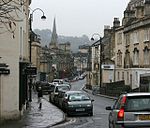Bathwick

Bathwick is an electoral ward in the City of Bath, England, on the opposite bank of the River Avon to the historic city centre. Bathwick was part of the hundred of Bath Forum.The district became part of the Bath urban area with the 18th century development of the Pulteney estate and the building of Pulteney Bridge. Subsequently various Georgian streets were built including Sydney Place, Great Pulteney Street and Laura Place, with Bathwick Hill leading up to Claverton Down and the University of Bath. It is also home to the Holburne Museum of Art within Sydney Gardens, Bath Recreation Ground, and Bath Cricket Club Ground. Bathwick has two churches: St John the Baptist, Bathwick and St Mary the Virgin, Bathwick. The latter was built in the early 19th century by John Pinch the Elder, and was where the band Muse recorded the organ sections on their second studio album Origin of Symmetry.
Excerpt from the Wikipedia article Bathwick (License: CC BY-SA 3.0, Authors, Images).Bathwick
Bathwick Street, Bath Walcot
Geographical coordinates (GPS) Address Website Nearby Places Show on map
Geographical coordinates (GPS)
| Latitude | Longitude |
|---|---|
| N 51.388 ° | E -2.3534 ° |
Address
Little Willows Day Nursery
Bathwick Street
BA2 6QH Bath, Walcot
England, United Kingdom
Open on Google Maps










